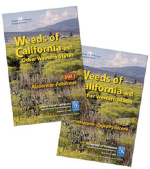If you don't already have a copy of Weeds of California and Other Western States, here's your chance to get it at lowest price I've seen: $45.00 (this price is good through May 6, 2021.)
Weeds of California and Other Western States
Preview in Google Books
- 13 shortcut identification tables for groups that share similar, unusual, or relatively uncommon characteristics.
- 2 grass identification keys - a key to all characteristics including inflorescences and reproductive parts and a key to vegetative characteristics only.
- 67 tables comparing important characteristics of difficult-to-distinguish weedy species.
- Color photos of over 700 weeds including seeds, seedlings, flowers, and mature plants.
- Appendix of non-native plants rarely or occasionally naturalized in California.
- Glossary of botanical terms.
- Bibliography of some of the most pertinent publications.
- Index to common names, scientific names, and synonyms.
Each entry describes the plant category, family name, common name, and synonyms along with a summary of the important aspects of the plant's life cycle, size, growth form, impact, method of introduction, and toxicity. You'll also find a description of the seedling, mature plant, roots and underground structures, flowers, fruits and seeds, spikelets and florets, spore-bearing structures, and post senescence characteristics for each entry.
Also includes a description of the habitat where each is typically found and distribution in California, other states, and worldwide, along with maximum elevation at which the species is found.
Rounding out each entry is a description of the methods of reproduction, seed dispersal, germination requirements and conditions, seed survival and longevity, early establishment characteristics and requirements, cultural practices and management options that have proven effective or ineffective in controlling infestations, and a notation of the species' inclusion on federal or state noxious weed lists.
To order, visit UC ANR Publications.